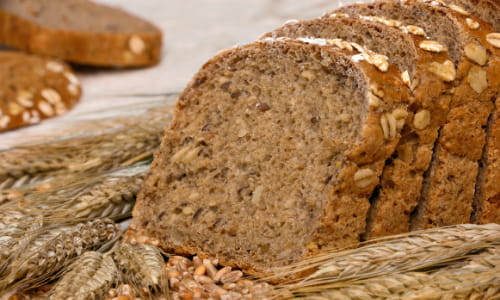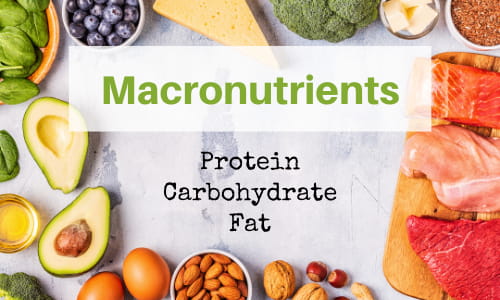11 Best High Fiber Bread Choices
“11 Best High Fiber Bread Choices” was written by Nina Deuschle & edited/reviewed by Aly Bouzek, MS, RDN. Nina is a dietetic intern based out of Florida.
Have you found yourself feeling overwhelmed by the number of options you see when you walk down the bread aisle at your grocery store?
This article will break down some of the benefits that different types of breads offer – so you can shop smarter and find the right high fiber bread for you!
In this article, you will learn about:
- Nutrition benefits of bread
- Importance (and definition!) of fiber
- What to look for when choosing bread
- Store-bought high fiber bread options
Why Eat Bread?
Bread is a nutrient-dense, affordable, and accessible food to keep in the pantry. Plus, no preparation required. Quick, nutritious meals can be planned around a simple loaf of bread.
Sadly, bread has developed a bad reputation recently. This is partly because of the popularity of low carbohydrate and ketogenic diets. However, you can be sure that bread, and carbohydrates as a whole, can play a very important role in a healthy diet.
Culturally, bread plays an important role for people around the world. It has historically been a staple of many diets, and many bakers enjoy the art (and science!) of bread-making.

Macronutrients in High Fiber Bread
Carbohydrates are our body’s and brain’s preferred source of energy. Some breads are mainly made up of simple carbohydrates, while others (like whole-grain breads) contain plenty of complex carbohydrates and fiber.
Active and sedentary people both benefit from the energy that carbohydrates provide. Whether you are training for a triathlon or solving a difficult problem at work, carbohydrates can help!
Some high fiber breads may also have some protein, which is another macronutrient. Other breads that may be gluten-free and grain-free might include seeds, which also provides some protein.
Bread contains a smaller percentage of fat, the third macronutrient. A store-bought slice of bread typically contains about 1 gram of fat, making it a low-fat food.

Micronutrients in High Fiber Bread
When foods are made from whole grains, they contain all parts of the grain seed. This means that they offer the benefits of micronutrients like B vitamins, iron, magnesium, and selenium.
Breads made with sprouted grains are especially rich in vitamin E, vitamin C, and beta-carotene. Below are some of the benefits of micronutrients found in bread:
- B vitamins: needed to convert food into energy
- Iron: helps the body transport oxygen
- Magnesium: helps with bone and heart health
- Selenium: powerful antioxidant that may reduce your risk of developing certain cancers
- Vitamin E: helps with vision, reproductive, and skin health
- Vitamin C: helps repair body tissue
- Beta-carotene: antioxidant that plays a role in eye health

What is Fiber?
Fiber is a food component that can’t be digested and absorbed in the same way that carbohydrates can. Therefore, it passes through the body undigested.
Soluble fiber, which can dissolve in water, is found in foods like oats, seeds, nuts, and beans. It turns into a gel during digestion and can make us feel fuller.
Insoluble fiber, on the other hand, does not dissolve in water. This is the type of fiber that acts as a broom in your digestive tract, preventing constipation. Most of the fiber found in 100% whole wheat breads is insoluble.
It is important to note that if your eating pattern typically does not include a lot of fiber, then you will want to introduce it slowly into your diet.
You’ll also want to make sure you drink water and stay hydrated. This will give your digestive system enough time to adjust to the change and hopefully help you avoid any discomfort.

Health Benefits of Fiber
Fiber can reduce the risk of developing cardiovascular disease, type 2 diabetes, colon cancer, and high blood pressure. Also, fiber is a great addition to your diet when you are trying to manage constipation. For more information, see our article about constipation in the elderly.
Fiber promotes better blood sugar control, which in turn affects our hunger levels and mental status. It is recommended that adults get at least 25-35 grams of fiber per day. Unfortunately, most Americans only get about 15 grams of fiber every day (1).
Below, we will discuss ways to make sure that you’re selecting breads that also have fiber.
Tips for Selecting a Loaf of High Fiber Bread
Food marketing and the wide variety of options at the store can make the choice seem overwhelming. Let’s chat about some of the ingredients you can be on the lookout for when you’re comparing brands at the store.
Ingredients to Look for
Food labels can make it tricky to distinguish foods that are truly rich in whole grains, from foods that just have a tiny amount of whole grains. To make sure that you’re actually buying whole grain bread, look for “100% whole-grain” at the very top of the ingredient list.
Some other grains besides wheat that are often found in high-fiber breads include oats, rye, barley, spelt, and millet.
If you usually buy 100% whole wheat bread, then you can introduce some new nutrients into your diet by trying a bread made with a different whole grain like those listed above.
For those with celiac disease or gluten intolerance, it can be harder to find high fiber breads; however, it’s not impossible!
Luckily, there are some very creative food manufacturers out there who have started making gluten-free breads with ingredients like brown rice flour, almond meal, chia seeds, and flax seeds. These ingredients all contribute to the fiber content of the final product.
High fiber breads will come with 3-5 grams of fiber per slice, and they will often pack in 3-6 grams of protein.
Sodium and Sugar
Most breads include some sodium and sugar.
Sometimes the sugar is naturally occurring, and other times it’s an added ingredient that’s used to enhance the flavor of the bread. A good rule of thumb is to look for a loaf of bread that has more grams of fiber per serving than grams of sugar.
If you’re watching your sodium intake, look for breads that have less than 200 milligrams per serving.

List: 11 Best High Fiber Bread Choices
The nutrition facts below are for 1 slice of bread:
1. Mestemacher Whole Rye Bread
Calories: 180
Carbs: 40 grams
Fiber: 8 grams
Protein: 4 grams
2. Barely Bread 100% Grain Free Bread
Calories: 90
Carbs: 6 grams
Fiber: 5 grams
Protein: 3 grams
3. Dave’s Killer Bread Powerseed
Calories: 100
Carbs: 18 grams
Fiber: 4 grams
Protein: 5 grams
4. Silver Hills Sprouted Power Squirrelly Bread
Calories: 100
Carbs: 15 grams
Fiber: 4 grams
Protein: 6 grams
5. Ezekiel 4:9 Sprouted Flax Bread
Calories: 80
Carbs: 14 grams
Fiber: 3 grams
Protein: 5 grams
6. Nature’s Own Double Fiber Wheat Bread
Calories: 50
Carbs: 11 grams
Fiber: 4 grams
Protein: 3 grams
7. Ezekiel 4:9 Sprouted Whole Grain Bread
Calories: 80
Carbs: 15 grams
Fiber: 3 grams
Protein: 5 grams
8. Oroweat 100% Whole Wheat Bread
Calories: 110
Carbs: 21 grams
Fiber: 3 grams
Protein: 4 grams
9. Arnold 12 Grain Bread
Calories: 110
Carbs: 19 grams
Fiber: 3 grams
Protein: 5 grams
10. Brownberry Organic Bread 22 Grains & Seeds
Calories: 140
Carbs: 23 grams
Fiber: 4 grams
Protein: 6 grams
11. Simple Truth Organic Sprouted Seeded Thin Sliced Bread
Calories: 70
Carbs: 13 grams
Fiber: 3 grams
Protein: 3 grams

Conclusion
There you have it! Bread is a nutritious, affordable food that also has the added benefits of fiber (depending on which type of bread you choose to enjoy). If you want to learn more about other ways to include more fiber in your diet, then take a look at our highest fiber food chart.
Have a favorite high fiber bread? Share it with us in the comments!
References:
- The Nutrition Source: Fiber. Harvard T.H. Chan. https://www.hsph.harvard.edu/nutritionsource/carbohydrates/fiber/.

Though bread may be one of those foods that people look at with skepticism, there are clear benefits to it, especially with high-fiber options. Great insight!
Why not mention Orowheat Double Fiber whole wheat bread? It’s got 6 grams of fiber per slice!!! And it’s delicious!
Thanks for the recommendation!